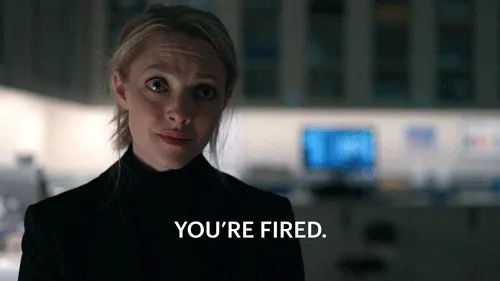What HR could’ve done differently in that viral firing video
HR should be prepared for the possibility that more employees will start sharing their layoff and firing experiences publicly.

The Dropout/Hulu via Giphy
• 4 min read
Courtney Vinopal is a senior reporter for HR Brew covering total rewards and compliance.
It was a termination watched ’round the world.
Brittany Pietsch, formerly an account executive at Cloudflare, filmed herself for nine minutes as she pressed HR to explain why she was being fired from the IT company. She posted the video to TikTok, where it went viral.
Those on the call, who Piestch said she’d never met, struggled to provide a concrete answer. Pietsch told the HR team informing her that she’d received nothing but positive feedback from her manager since starting her position in August, and couldn’t make sense of the fact she was being let go for reasons related to “2023 performance.” At one point, someone on the call can be heard telling Pietsch they didn’t think HR would be able to give her “any clarity or answers [that are] going to meet the expectations that you’re communicating to us.”
In a post on X, Cloudflare CEO Matthew Prince said Pietsch was one of about 40 salespeople fired, a “normal quarter” for the company. He expressed regret that the company was not more “kind and humane” in delivering the news.
HR should be prepared for the possibility that more employees will start sharing their layoff and firing experiences publicly, Matt Bradburn, founder and CEO of The People Collective, told HR Brew. “Every HR team is now on watch,” he said.
So what could HR have done differently in this case? Bradburn and two other people pros who advise companies on these issues offered their thoughts.
Bring in the manager. Bradburn said he was surprised to hear Pietsch’s manager was missing from the call, and Pietsch claimed in a LinkedIn post that her manager didn’t even know she was being fired. (Cloudflare didn’t respond to a request for comment about Pietsch’s post.)
“Where’s the manager in all of this?” Bradburn said. “Folks, let managers know if you’re letting part of their teams go…the manager should have a level of accountability or ownership over their own teams.”
Lisa Lindsey, an executive coach and HR consultant with Peale Piper, told us managers may not always get the advance heads-up if one of their workers is being let go, particularly in a large organization. But at the very least, the affected employee should know who the messengers are. “At minimum, the manager should be in the room, and an HR representative that they know, and they’re familiar with,” she said.
Quick-to-read HR news & insights
From recruiting and retention to company culture and the latest in HR tech, HR Brew delivers up-to-date industry news and tips to help HR pros stay nimble in today’s fast-changing business environment.
Avoid surprises. Issues with an employee’s performance should never come as a surprise, particularly in the case of layoffs that are ostensibly based on those factors, said Dani Herrera, a DE&I and talent consultant.
“No performance layoff, or firing, should be unannounced,” Herrera said. “As HR, and managers, we need to have previous conversations with the person…this cannot come out of the blue.”
Companies should also consider how they’re evaluating employees based on performance, she added. She noted Pietsch said she’d only been there for three or four months, and in most companies, the onboarding and ramp-up process typically takes about that long to complete. Giving employees just a couple of months to start meeting the job expectations is not enough time, Herrera suggested.
Lindsey echoed this: “When we’re talking about performance, and we’re letting you go because of performance reasons, there should be no air, no daylight, between what the company expects for performance, and what the employee understands about how they are achieving that performance. It’s all about clarity and communication.”
Go in with a communication plan. HR teams should have tools to empathize with the way employees are feeling about being laid off or fired, and how it could impact them, Bradburn said. Ahead of the conversation, managers should get involved, and help HR structure responses for a range of different questions.
“What does the worst case scenario look like on this call? And how are you going to deal with it?” he said. “Because if you can't think that through, you're going to struggle to have this end up in an amicable or productive outcome.”
Crafting these responses may be challenging, given HR is sometimes kept in the dark about why exactly employees are being let go.
It’s on HR to gather context from higher-ups so they’re as prepared as possible for these conversations. If they’re an HR executive with a seat at the table, they can remind their colleagues that, at the end of the day, business decisions like firings and layoffs affect human beings.
“Sometimes it is extremely hard to push back on your CEO or your CFO, whoever that is that is giving you that information,” Herrera said. “But we cannot have those conversations without knowing what’s happening.”
Quick-to-read HR news & insights
From recruiting and retention to company culture and the latest in HR tech, HR Brew delivers up-to-date industry news and tips to help HR pros stay nimble in today’s fast-changing business environment.